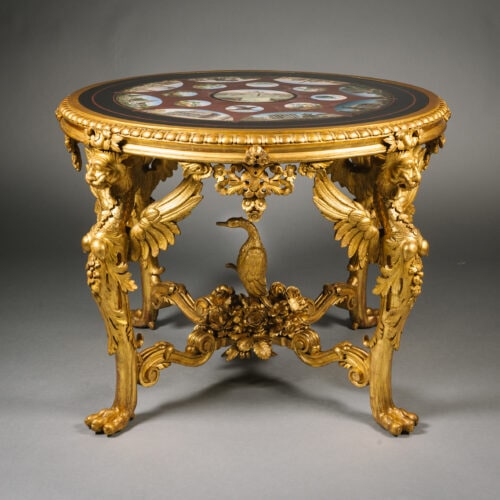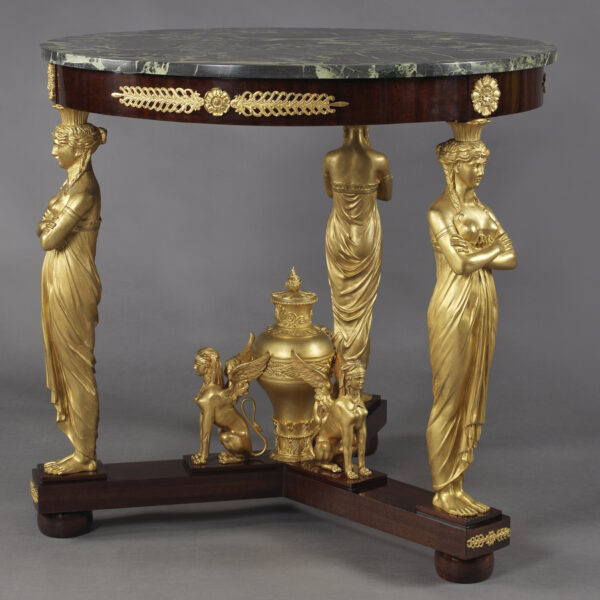François Linke
A Fine Louis XVI Style Gilt-Bronze Mounted Mahogany Dining Suite
£148,000
Dimensions
Height: 76 cm (30 in)Width: 126 cm (50 in)
Depth: 156 cm (62 in)
Description
A Fine Louis XVI Style Gilt-Bronze Mounted Mahogany Dining Suite by François Linke, Paris.
This suite comprises a dining table, eight chairs and a buffet.
Signed ‘Ct LINKE SERRURERIE PARIS’ on the back of the drawer locks.
The dining table with ‘D’-shaped ends and above a panelled frieze with pierced fluted and stiff-leaf cast frieze, on four tapering fluted legs headed by paterae mounts. The extending mechanism with central folding leg supports and two later leaves.
The eight dining chairs en suite; each with oval cane work back and seat with squab cushion.
The buffet or side cabinet exhibits all the hallmarks of the fine cabinetmaking for which François Linke was acclaimed. The original marble is finely finished rare slab of Brocatelle violette du Jura. The frieze is ornamented with a pierced stiff-leaf cast mount and fronted by two long drawers above a pair of panelled doors enclosing an adjustable shelf. The curved sides with conforming drawers above doors. On short tapering fluted legs with gilt-bronze caps.
French, Circa 1890.
Dining table:
Height:76 cm | 30 in
Width:126 cm | 50 in
Length:
156 cm | 61 1/2 in, closed
218 cm | 85 3/4 in, with one leaf
280 cm | 110 1/4 in, with two leaves
Dining chairs:
Height: 93 cm | 37 in
Width: 45 cm | 18 in
Depth: 51 cm | 20 in
Buffet:101 cm | 40 in
205 cm | 23 in
59 cm | 23 in
Date
Circa 1890
Origin
France
Medium
Gilt-Bronze Mounted Mahogany
Signature
Signed 'Ct LINKE SERRURERIE PARIS' on the back of the drawer locks
François Linke (1855 – 1946) was the most important Parisian cabinet maker of the late nineteenth and early twentieth centuries, and possibly the most sought after cabinet maker of his period.
He was born in 1855 in the small village of Pankraz, in what is now the Czech Republic. Records show that Linke served an apprenticeship with the master cabinetmaker Neumann, then in 1875 at the age of 20 he arrived in Paris where he lived until he died in 1946.
It is known that the fledgling Linke workshops were active in Paris in the Faubourg St. Antoine as early as 1881, and during this time he supplied furniture for other more established makers such as Jansen and Krieger.
The quality of Linke’s craftsmanship was unsurpassed by any of his contemporaries and reached its peak with his spectacular stand at the Paris Exposition Universelle in 1900, where his Grand Bureau took the gold medal. He gambled his fortune and reputation on this stand, exhibiting several breathtaking items of furniture with sculptural mounts of the most exceptional quality and proportion. His gamble worked and his reputation was established to such an extent that Linke continued to be the pre-eminent furniture house in Paris until the Second World War.
As the Art Journal reported in 1900 on Linke’s stand:
‘The work of M. Linke … was an example of what can be done by seeking inspiration amongst the classic examples of Louis XV and XVI without in any great sense copying these great works. M. Linke’s work was original in the true sense of the word, and as such commended itself to the intelligent seeker after the really artistic things of the Exhibition. Wonderful talent was employed in producing the magnificent pieces of furniture displayed….’
The formation of Linke’s distinctive style was made possible by his collaboration with the sculptor Léon Messagé. Together Linke and Messagé designed furniture for Linke’s 1900 exhibition stand, with exuberant allegorical figures cast in high relief, that exemplified Linke’s ability to seamlessly merge the different mediums of wood carving, bronze and marquetry into a dynamic unified whole.
Today Linke is best known for the exceptionally high quality of his work, as well as his individualism and inventiveness. All of his work has the finest, most lavish mounts, very often applied to comparatively simple carcasses. The technical brilliance of his work and the artistic change that it represented were never to be repeated.
Bibliography:
Payne, Christopher. François Linke, (1855 – 1946), The Belle Époque of French Furniture, Antique Collectors’ Club, (Woodbridge, UK), 2003.
Meyer, Jonathan. Great Exhibitions – London, New York, Paris, Philadelphia, 1851-1900, Antique Collectors’ Club, (Woodbridge, UK), 2006; pp. 298 – 300.
Ledoux – Lebard, Denise. Les Ébénistes du XIXe siècle, Les Editions de l’Amateur, (Paris), 1984; pp. 439-43.
Revue Artistique & Industrielle, (Paris), July-August 1900.
Coral Thomsen, D. (ed), The Paris Exhibition 1900, The Art Journal, 1901; p.341.





















 Print
Print


